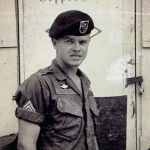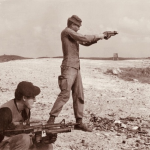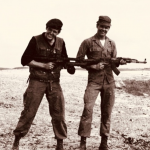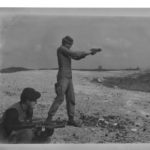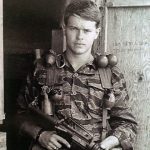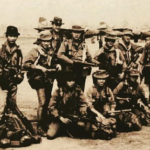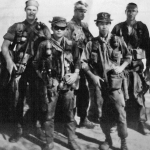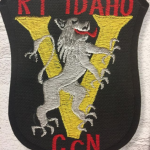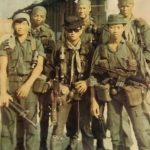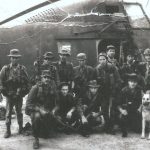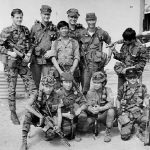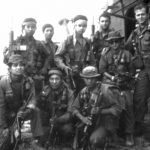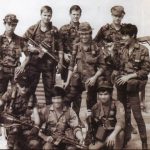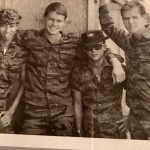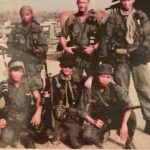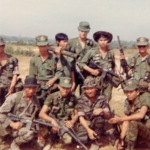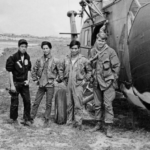
-
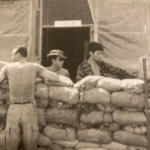
- This is a photograph of Khanh Cowboy Doan taken in front of recon team Idaho team room in 1968 FOB 1 in Phu Bai. Cowboy is standing with RT Idaho interpreter Nguyen Cong Hiep – with sunglasses, and Spider Parks.
-
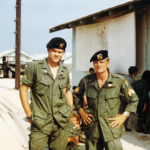
- CCN, Apr 69-Myself & Mark, standing next to US Mess Hall, camera is facing east toward Recon Com. Area. By John S. “Tilt” Meyer
-
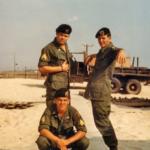
- Photo from CCN, April 1969. From left: me standing, Rick Estes, squatting, and Lynne M. Black Jr. The photo was taken in Recon area of CCN, the camera is facing north. By John “Tilt” Meyer
-

- Photo Apr 69, CCN, from left: Ron Podlaski, myself, Mark Gentry and Lynne M. Black Jr. By: John “Tilt” Meyer
-
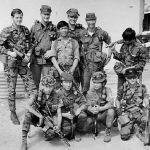
- Front row kneeling at FOB 1 Phu Bai fall 1968, from left: Sau – Vietnamese team leader, Tuan – grenadier, Cau & Hiep – interpreter. Back row from left: Lynne M. Black Jr., Don Wolken, Phouc – point man, John S.Meyer, Robert J. Parks and Chau.
-
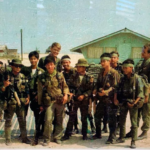
- his 1969 photo of RT Idaho at CCN, one of the only photos with Lynne M Black Jr, – Back row right, Doug “The Frenchman” LeTourneau – 2nd from right back and myself, back row,
-
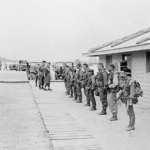
- RT Idaho getting at a pre-mission inspection at CCN, Da Nang in April 1969 next to CCN Headquarters. Team members from right: Cau, Doug “The Frenchman” LeTourneau, Capt. Mike O’Byrne, Hung, Fontenberry, Lynne M. Black Jr., Hiep, Sau, Son and Myself.
John Stryker “Tilt” Meyer
Born Jan. 19, 1946, John Stryker Meyer entered the Army Dec. 1, 1966, completed basic training at Ft. Dix, N.J., advanced infantry training at Ft. Gordon, Ga., jump school at Ft. Benning, Ga., and graduated from the Special Forces Qualification Course in Dec. 1967. He arrived at FOB 1 Phu Bai in May 1968, where he joined Spike Team Idaho, which transferred to Command & Control North, CCN in Da Nang, January 1969. In October 1969 he rejoined RT Idaho at CCN. That tour of duty ended suddenly in April 1970. Today he is a program director at the Veterans Affordable Housing Program, based in Orange, CA and joined the SOFREP team of correspondents in March 2015. He has written two non-fiction books on SOG secret wars: Across The Fence: The Secret War in Vietnam – Expanded Edition, and Co-Authored On The Ground: The Secret War in Vietnam with John E. Peters, a member of RT Rhode Island. Meyer’s website is: www.sogchronicles.com.
On The Ground: The Secret War in Vietnam Paperback – July 2, 2018
During the Vietnam War, a “secret war” was fought across the fence in Laos, Cambodia and North Vietnam, unknown to the media or the public, under the aegis of the Military Assistance Command Vietnam’s top secret Studies and Observation Group. SOG’s chain of command for missions and after-action reports extended to the White House and the Joint Chiefs of Staff. Small Green Beret-lead teams ran missions into Laos, Cambodia, and North Vietnam without assistance from conventional artillery, tank or infantry units. Once on the ground, their sole support was provided by Air Force Tactical Air and helicopter units, U.S. Army and Marine helicopter aviation personnel and aircrews, and from the South Vietnam Air Force’s 219th Special Operations Squadron, code named Kingbees. In Laos, the communists dedicated 50,000 troops to the Ho Chi Minh Trail, including highly trained sappers from the 305th Sapper Battalion, its sole mission: attack SOG teams.

From 1964 to 1972, far beyond the battlefields of Vietnam and the glare of media distortions, American Green Berets and their indigenous troops fought a deadly secret war in Laos, Cambodia and North Vietnam under the aegis of the top secret Military Assistance Command Vietnam — Studies and Observations Group, or simply SOG.
Buy this book at amazon: Follow Link: https://www.amazon.com/SOG-Chronicles-John-Stryker-Meyer-ebook/dp/B076B749PF
Across the Fence Paperback –
June 20, 2013
For eight years, far beyond the battlefields of Vietnam and the glare of media distortions, American Green Berets fought a deadly secret war in Laos and Cambodia under the aegis of the top secret Military Assistance Command Vietnam Studies and Observations Group, or SOG. Go deep into the jungle with five SOG warriors surrounded by 10,000 enemy troops as they stack up the dead to build a human buttress for protection. Witness a Green Beret, shot in the back four times and left for dead, who survives to fight savagely against incredible odds to complete his missions. Shudder as an enemy soldier touches a Green Beret s boot in the dark of night. Cringe as a Sergeant on SOG Spike Team Louisiana calls in an air strike on his team to break an enemy s wave attack. A team member dies instantly, and a Green Beret has an out-of-body experience as he watches his leg get blown off. Anyone interested in the Vietnam War in general, and the secret war in particular, will appreciate this well-written narrative of a SOG warrior’s first tour of duty at FOB 1, the Phu Bai launch site for what would eventually be known as CCN. The author, whose nickname “Tilt” comes from his days as a youngster playing pinball machines in Trenton, New Jersey, is an educated, skilled writer who has taken what others might recite as cold facts and woven a taut, suspenseful series of episodes from one of the deadliest years in the history of the Studies and Observation Group. The history of this war will not be told by one book, but Tilt has added an important piece to what one day will be a total picture of the Second Indochina War. The book opens with Tilt’s arrival in country and his journey to Phu Bai, where he lands just in time to witness the disappearance of Spike Team Idaho into the maws of the North Vietnamese Army in Laos. As he checks in, gets his gear, and becomes familiar with the small camp, the tension builds as continued silence from the field signals the worst possible fate for the veterans on ST Idaho. The gravity of the situation, both for the missing team and for the Bright Light team that is given the duty to go back in to see what happened, is palpable. The events which follow and the inescapable conclusion reached by the team leader of the Bright Light leave no doubt in the mind of the young Green Beret that he has joined a dangerous outfit – just as the folks back at Training Group warned him. Regardless of his realization, the fact that he confronts his mortality and chooses to go on is testament to his courage, a courage which will be needed in spades as he begins his seasoning in earnest. As he undertakes his first missions, and as close calls get closer and closer, Tilt witnesses (and the reader experiences with him) men under stress who react in expected, and quietly respected, ways. It is no shame for a recon man to pull himself off a team after a particularly dangerous mission where the reaper’s scythe has missed him by centimeters. A couple of examples of extraordinary courage under fire by team members followed by their decision to leave the team humanize the stories, since the reader must wonder, What would I do under similar circumstances? It is this aspect of the book which gives it a richness which is often lacking in war memoirs. In one particularly chilling example (especially for anyone who ever rode out on a “string”) involves Tilt’s extrication from a hot insertion point in which he is forced to use a Swiss seat. Because of the stress of the situation, he fails to secure his second D ring and as soon as the helicopter takes off, Tilt begins to . . . well . . . tilt. Not humorous at all to be dangling upside down from 4,000 feet as your Swiss seat begins to make its way off your waist, down your hips, down your knees . . . . My hands were dripping with sweat as he related this event.




